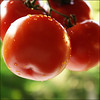 Acne vulgaris
Acne vulgaris (commonly called acne) is an extremely common
skin condition, caused by changes in pilosebaceous units, skin structures consisting of a
hair follicle and its associated
sebaceous gland, via
androgen stimulation. It is characterized by noninflammatory follicular
papules or
comedones and by inflammatory papules,
pustules, and
nodules in its more severe forms. Acne vulgaris affects the areas of skin with the densest population of sebaceous follicles; these areas include the face, the upper part of the chest, and the back. Severe acne is
inflammatory, but acne can also manifest in noninflammatory forms.Acne lesions are commonly referred to as
pimples, blemishes, spots, zits, or simply acne.
Acne occurs most commonly during
adolescence, affecting more than 89% of teenagers, and frequently continues into adulthood. In adolescence, acne is usually caused by an increase in male sex hormones, which people of both genders accrue during puberty. For most people, acne diminishes over time and tends to disappear—or at the very least decrease—after one reaches one's early twenties. There is, however, no way to predict how long it will take to disappear entirely, and some individuals will carry this condition well into their thirties, forties and beyond.
The
face and upper neck are the most commonly affected, but the
chest,
back and
shoulders may have acne as well. The upper
arms can also have acne, but lesions found there are often
keratosis pilaris, not acne. Typical acne lesions are comedones, inflammatory papules, pustules and nodules. Some of the large nodules were previously called "
cysts" and the term nodulocystic has been used to describe severe cases of inflammatory acne.
Aside from scarring, its main effects are psychological, such as reduced
self-esteemand, according to at least one study,
depression or
suicide. Acne usually appears during
adolescence, when people already tend to be most socially insecure. Early and aggressive treatment is therefore advocated by some to lessen the overall impact to individuals.
Different types of Acne Vulgaris:
A: Cystic acne on the face
B: Subsiding tropical acne of trunk
C: Extensive acne on chest and shoulders.
Terminology
The term
acne comes from a corruption of the
Greek άκμή (acne in the sense of a skin eruption) in the writings of
Aëtius Amidenus. Used by itself, the term "acne" refers to the presence of
pustules and
papules.
[7] The most common form of acne is known as "acne vulgaris", meaning "common acne". Many teenagers get this type of acne. Use of the term "acne vulgaris" implies the presence of
comedones.
[8]The term "acne rosacea" is a synonym for
rosacea, however some individuals may have almost no acne comedones associated with their rosacea and prefer therefore the term rosacea.
[9] Chloracne is associated with exposure to
polyhalogenated compounds.
Causes of acneAcne develops as a result of blockages in
follicles.
Hyperkeratinization and formation of a plug of
keratin and
sebum (a
microcomedo) is the earliest change. Enlargement of sebaceous glands and an increase in sebum production occur with increased
androgen (
DHEA-S) production at
adrenarche. The microcomedo may enlarge to form an open comedone (
blackhead) or closed comedone (whitehead). Whiteheads are the direct result of
skin pores becoming clogged with
sebum, a naturally occurring oil, and dead skin cells. In these conditions the naturally occurring largely
commensal bacteria
Propionibacterium acnes can cause
inflammation, leading to inflammatory lesions (
papules, infected pustules, or nodules) in the
dermis around the microcomedo or comedone, which results in redness and may result in
scarring or
hyperpigmentation.
Primary causesAcne is known to be partly hereditary. Several factors are known to be linked to acne:
Family/Genetic history. The tendency to develop acne runs in families. For example, school-age boys with acne often have other members in their family with acne as well. A family history of acne is associated with an earlier occurrence of acne and an increased number of retentional acne lesions.
Hormonal activity, such as
menstrual cycles and
puberty. During puberty, an increase in male sex hormones called androgens cause the follicular glands to grow larger and make more sebum.
Inflammation, skin irritation or scratching of any sort will activate inflammation.
Stress. While the connection between acne and stress has been debated, scientific research indicates that "increased acne severity" is "significantly associated with increased stress levels."
The National Institutes of Health (USA) list stress as a factor that "can cause an acne flare."A study of adolescents in Singapore "observed a statistically significant positive correlation […] between stress levels and severity of acne."
Hyperactive sebaceous glands, secondary to the three hormone sources above.
Bacteria in the
pores.
Propionibacterium acnes (P. acnes) is the anaerobic bacterium that causes acne. In-vitro resistance of P. acnes to commonly used antibiotics has been increasing.
Use of anabolic steroids.Exposure to certain chemical compounds.
Chloracne is particularly linked to toxic exposure to
dioxins, namely
Chlorinated dioxins.[
citation needed]
Chronic use of
amphetamines or other similar drugs.
from :
http://en.wikipedia.org/wiki/Acne
 The time when we are most prone to acne pimples will be when we were teenagers. And you will most probably consult your parents and the number one advise was to stop squeezing the pus out of the red blemish. Apparently by squeezing, you will make it worse. But do we actually know why it will only magnify our problems?
The time when we are most prone to acne pimples will be when we were teenagers. And you will most probably consult your parents and the number one advise was to stop squeezing the pus out of the red blemish. Apparently by squeezing, you will make it worse. But do we actually know why it will only magnify our problems?









